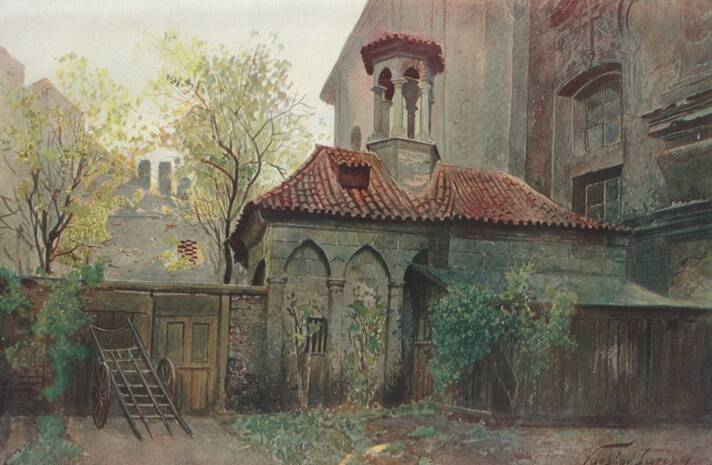The work of Jan Blažej Santini Aichel accessible to all senses - this is the purpose of a mobile application using augmented reality, a new website with the possibility of viewing a 3D model in virtual reality and a haptic model for the blind. All these information tools will enhance the experience of the Chapel of the Holy Sepulchre on Zderaz in Prague 2, which was created by a brilliant architect more than three hundred years ago. The Faculty of Electrical Engineering of the Czech Technical University, on whose campus the baroque building is located, will present them for the first time on Saturday, 18 May 2024 during the Open House Prague festival. In addition to the chapel near Charles Square, FER CTU will once again offer those interested in architecture a tour of the High Voltage Laboratory in Prague 6 - Dejvice, including attractive demonstrations of electrical discharges.
The Santini Chapel is located in the rear courtyard area accessible only to the faculty staff. "The Open House Prague festival is the first ever opportunity for the public to see it, including a look inside the chapel. The chapel is currently empty and we will be preparing its reconstruction. We intend to continue to make the work of this important architect available on appropriate occasions," said the Dean of the Faculty of Electrical Engineering of CTU, Prof. Petr Páta.
"The Chapel of the Holy Sepulchre is one of the few reminders of the remarkable and dramatic history of the Crusader monastery at Zderaz. It is also a unique testimony to the extinct but extremely interesting building of the Church of St. Peter and Paul, whose author was the exceptional architect Jan Blažej Santini-Aichel. Unfortunately, the church was demolished in 1904, but its appearance has been preserved in photographs and a contemporary plan. Thanks to them, we know that it was a remarkable building whose spatial design belonged to the peak phase of Santini's work. Santini's authorship is also evident in the surviving chapel, which is a faithful evocation of the Jerusalem model, but at the same time is characterised by a dynamically composed conclusion with a typical Santini creative handwriting," says the expert on Santini's work, Assoc. Richard Biegel from the Institute of Art History of the Faculty of Arts of Charles University. Richard Biegel is also the author of the accompanying texts on the website and the information board, which introduce those interested in the history of Santini's work and the place where the building of the present Faculty of Electrical Engineering on the campus of Charles Square was built in 1905-6.
How the digital versions of the Chapel of the Holy Sepulchre were created
FEL CTU, a faculty that trains top computer scientists and electrical engineers, used its competence in research and development of virtual and augmented reality to create applications that allow people to see Santini's Chapel from behind closed gates or view it in a web browser through virtual reality glasses. For these purposes, Dr. David Sedláček, head of the VR laboratory of the Department of Computer Graphics and Interaction at CTU FEL, first prepared a 3D model of the building.
"As a first step, the chapel had to be photographed in cooperation with AgentFly. In total, more than 900 photographs were taken from the ground and from the air, supplemented by 360° scanning using a laser scanner. The resulting 3D model has more than 230 million points. However, for the web preview we use a model with about 240,000 triangles," explains David Sedláček. The virtual reality expert also printed the model on a 3D printer in collaboration with his department colleague Dr. Miloslav Macík, who specializes in tactile interfaces for the blind.
"The digitized 3D model allows you to virtually enter the Santini Chapel and walk through it in a web environment. In addition, if you have 3D virtual reality glasses, the perception of the architecture is all the more intense," says David Sedláček. The augmented reality-based mobile app will be most appreciated by visitors on site when the entrance gate to the courtyard is closed, as it can erase this obstacle.
The augmented reality app for iOS and Android is free. Download links will be posted at https://fel.cvut.cz/cs/fakulta/struktura-fakulty/kaple.
Annotation from the Open House Prague 2024 programme
Chapel of the Holy Sepulchre on Zderaz
Address Na Zbořenci 277/16, Prague 2, Faculty of Electrical Engineering, CTU in Prague
Dates 1715-1721; 1905 (reconstruction)
Architect: Jan Blažej Santini-Aichel
Typological section: sacral buildings
The Chapel of the Holy Sepulchre at Zderaz is the last remnant of the former monastery of the Crusaders - the Guardians of the Holy Sepulchre, which was built by Charles IV. As one of the few chapels of the Holy Sepulchre in the Czech Republic, it faithfully copies its Jerusalem model. Interestingly, its façade with a triangular gable and circular window dates back to the beginning of the 20th century, when most of the convent complex was demolished as part of the redevelopment of Prague. If you are interested in the work of the important architect Jan Blazej Santini-Aichel, you should not miss this hidden gem of sacral architecture during your visit to the CTU campus in Prague!
Faculty of Electrical Engineering, CTU in Prague
Address Technická 1902/2, Prague 6
Date 1959-1964
Architect(s) František Čermák and Gustav Paul
Typological section: education and research
The building with a façade covered with coloured metal panels in combination with ceramics, drawing inspiration from the so-called Brussels style, began construction in Dejvice in 1957. It includes the hall of the high voltage laboratory, where you can see giant balls, coils and tubes. These are test sources for the production of electric discharges. Come and experience the most beautiful storm of your life!






